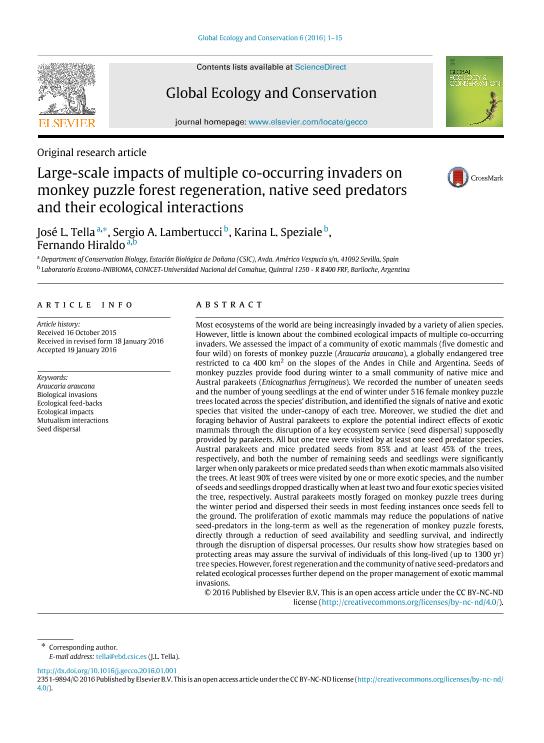Mostrar el registro sencillo del ítem
dc.contributor.author
Tella, José L.
dc.contributor.author
Lambertucci, Sergio Agustin

dc.contributor.author
Speziale, Karina Lilian

dc.contributor.author
Hiraldo, Fernando

dc.date.available
2018-09-24T20:17:45Z
dc.date.issued
2016-04
dc.identifier.citation
Tella, José L.; Lambertucci, Sergio Agustin; Speziale, Karina Lilian; Hiraldo, Fernando; Large-scale impacts of multiple co-occurring invaders on monkey puzzle forest regeneration, native seed predators and their ecological interactions; Elsevier; Global Ecology and Conservation; 6; 4-2016; 1-15
dc.identifier.issn
2351-9894
dc.identifier.uri
http://hdl.handle.net/11336/60818
dc.description.abstract
Most ecosystems of the world are being increasingly invaded by a variety of alien species. However, little is known about the combined ecological impacts of multiple co-occurring invaders. We assessed the impact of a community of exotic mammals (five domestic and four wild) on forests of monkey puzzle (Araucaria araucana), a globally endangered tree restricted to ca 400 km2 on the slopes of the Andes in Chile and Argentina. Seeds of monkey puzzles provide food during winter to a small community of native mice and Austral parakeets (Enicognathus ferrugineus). We recorded the number of uneaten seeds and the number of young seedlings at the end of winter under 516 female monkey puzzle trees located across the species' distribution, and identified the signals of native and exotic species that visited the under-canopy of each tree. Moreover, we studied the diet and foraging behavior of Austral parakeets to explore the potential indirect effects of exotic mammals through the disruption of a key ecosystem service (seed dispersal) supposedly provided by parakeets. All but one tree were visited by at least one seed predator species. Austral parakeets and mice predated seeds from 85% and at least 45% of the trees, respectively, and both the number of remaining seeds and seedlings were significantly larger when only parakeets or mice predated seeds than when exotic mammals also visited the trees. At least 90% of trees were visited by one or more exotic species, and the number of seeds and seedlings dropped drastically when at least two and four exotic species visited the tree, respectively. Austral parakeets mostly foraged on monkey puzzle trees during the winter period and dispersed their seeds in most feeding instances once seeds fell to the ground. The proliferation of exotic mammals may reduce the populations of native seed-predators in the long-term as well as the regeneration of monkey puzzle forests, directly through a reduction of seed availability and seedling survival, and indirectly through the disruption of dispersal processes. Our results show how strategies based on protecting areas may assure the survival of individuals of this long-lived (up to 1300 yr) tree species. However, forest regeneration and the community of native seed-predators and related ecological processes further depend on the proper management of exotic mammal invasions.
dc.format
application/pdf
dc.language.iso
eng
dc.publisher
Elsevier

dc.rights
info:eu-repo/semantics/openAccess
dc.rights.uri
https://creativecommons.org/licenses/by-nc-nd/2.5/ar/
dc.subject
ARAUCARIA ARAUCANA
dc.subject
BIOLOGICAL INVASIONS
dc.subject
ECOLOGICAL FEED-BACKS
dc.subject
ECOLOGICAL IMPACTS
dc.subject
MUTUALISM INTERACTIONS
dc.subject
SEED DISPERSAL
dc.subject.classification
Otras Ciencias Biológicas

dc.subject.classification
Ciencias Biológicas

dc.subject.classification
CIENCIAS NATURALES Y EXACTAS

dc.title
Large-scale impacts of multiple co-occurring invaders on monkey puzzle forest regeneration, native seed predators and their ecological interactions
dc.type
info:eu-repo/semantics/article
dc.type
info:ar-repo/semantics/artículo
dc.type
info:eu-repo/semantics/publishedVersion
dc.date.updated
2018-09-24T13:53:24Z
dc.journal.volume
6
dc.journal.pagination
1-15
dc.journal.pais
Países Bajos

dc.journal.ciudad
Amsterdam
dc.description.fil
Fil: Tella, José L.. Consejo Superior de Investigaciones Científicas; España
dc.description.fil
Fil: Lambertucci, Sergio Agustin. Consejo Nacional de Investigaciones Científicas y Técnicas. Centro Científico Tecnológico Conicet - Patagonia Norte. Instituto de Investigaciones en Biodiversidad y Medioambiente. Universidad Nacional del Comahue. Centro Regional Universidad Bariloche. Instituto de Investigaciones en Biodiversidad y Medioambiente; Argentina
dc.description.fil
Fil: Speziale, Karina Lilian. Consejo Nacional de Investigaciones Científicas y Técnicas. Centro Científico Tecnológico Conicet - Patagonia Norte. Instituto de Investigaciones en Biodiversidad y Medioambiente. Universidad Nacional del Comahue. Centro Regional Universidad Bariloche. Instituto de Investigaciones en Biodiversidad y Medioambiente; Argentina
dc.description.fil
Fil: Hiraldo, Fernando. Consejo Superior de Investigaciones Científicas; España. Consejo Nacional de Investigaciones Científicas y Técnicas. Centro Científico Tecnológico Conicet - Patagonia Norte. Instituto de Investigaciones en Biodiversidad y Medioambiente. Universidad Nacional del Comahue. Centro Regional Universidad Bariloche. Instituto de Investigaciones en Biodiversidad y Medioambiente; Argentina
dc.journal.title
Global Ecology and Conservation
dc.relation.alternativeid
info:eu-repo/semantics/altIdentifier/doi/https://dx.doi.org/10.1016/j.gecco.2016.01.001
dc.relation.alternativeid
info:eu-repo/semantics/altIdentifier/url/https://www.sciencedirect.com/science/article/pii/S2351989415300275
Archivos asociados
